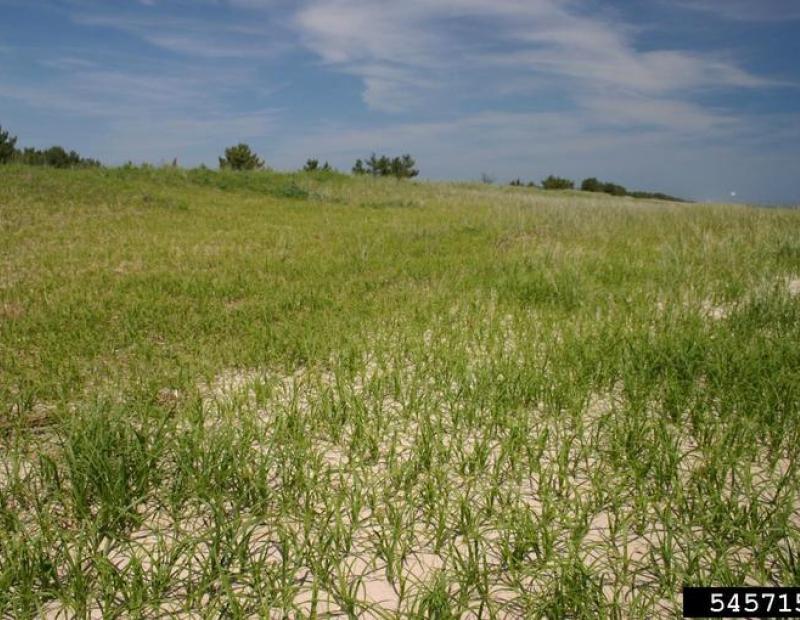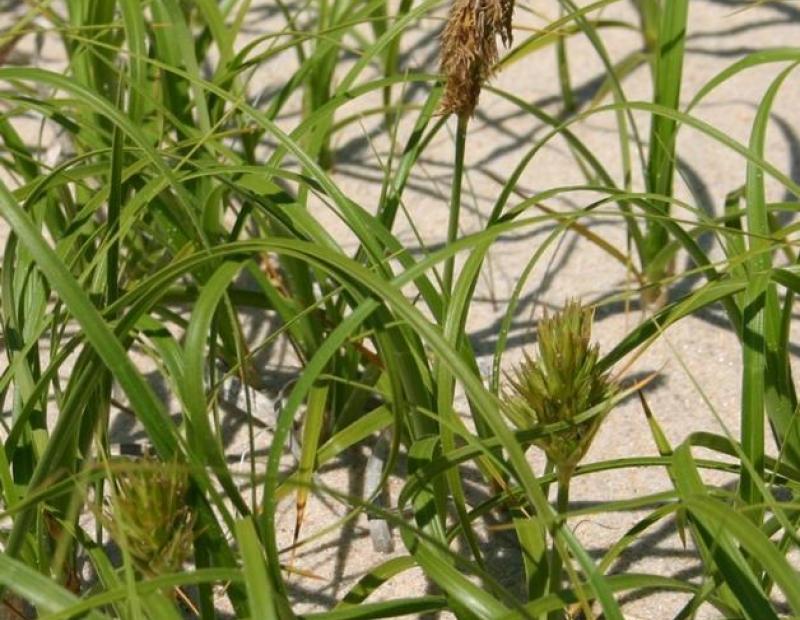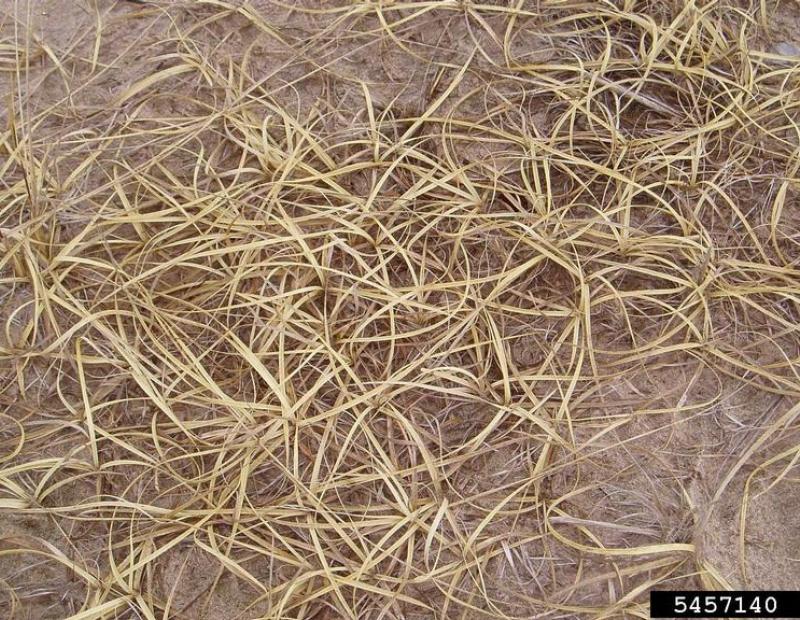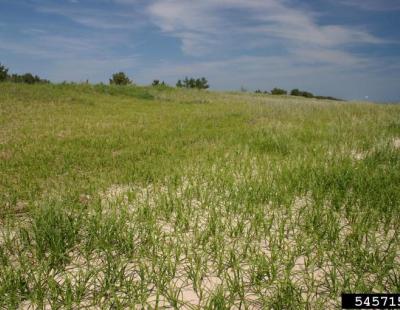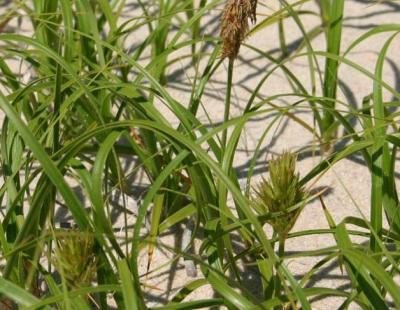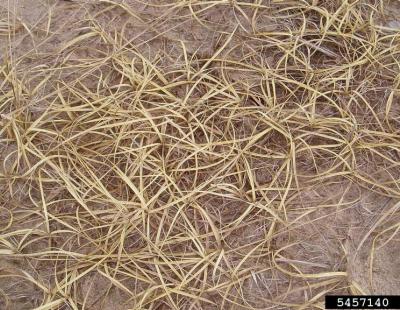Vertical Tabs
- Asiatic sand sedge is a member of the Sedge family (Cyperaceae).
- A robust, mat-forming perennial sedge, Asiatic sand sedge is rhizomatous, yellow-green in color, and has stiff, arching leaves. Growing four inches to, rarely, almost a foot tall, this species is most conspicuous when occurring as a mass. (3)
Leaves
Leaves are stiff, sharply serrated, ‘V’ shaped in cross section and yellow-green in color. Stems are triangular in cross section. (3)
Flowers
Flowers are arranged in short, dark brown spikes and emerge in early summer. These drab, upright inflorescences contain both male and female flowers. (4)
Fruit/Seed
Seeds mature in summer and require scarification and a cold, moist period to germinate. (6)
Asiatic sand sedge is a fast growing, aggressive sedge species native to coastal China, Korea, and Japan. Extremely difficult to control due to an expansive, deeply buried network of rhizomes, the dense mats this sedge forms are capable of altering native species diversity and changing the dynamics of dune systems. Some studies suggest dunes colonized by Asiatic sand sedge make coastal habitats more vulnerable to erosion, while others suggest they stabilize dune systems too much, limiting the natural flux of this changing habitat. (1). Furthermore, Asiatic sand sedge may directly threaten several endangered beach species including piping plover, beach tiger beetles and sea beach amaranth due to reduction of habitat and direct competition. (6)
Biological Control
There is no biological control agent currently in use against this species.
Manual or Mechanical Control
Pulling / Digging Up: Pulling by hand is a time-consuming task and is only effective on small populations. Care must be taken to remove all below ground roots and rhizomes. Gloves are recommended. (5)
Mowing: Not effective. Deeply buried rhizomes quickly re-sprout when above-ground material is cut.
Girdling: Not applicable
Prescribed Fire: No information available
Prescribed Grazing: Not applicable
Soil Tilling: Not advisable. Tilling will fragment roots and encourage re-sprouting.
Mulching: Not applicable
Solarization: Not applicable
Hot Foam Spray: Not applicable
Chemical Control
The pesticide application rates and usage herein are recommendations based on research and interviews with land managers. When considering the use of pesticides, it is your responsibility to fully understand the laws, regulations and best practices required to apply pesticides in a responsible manner. At times, the pest you seek to treat may not be on a pesticide label, requiring a 2ee exemption from NYSDEC. Always thoroughly read the label of any pesticide and consult the NYSDEC or a licensed pesticide applicator with questions.
Foliar Spray: A 2-3% solution of glyphosate is effective at managing populations of Asiatic sand sedge. Repeat treatments are necessary at least twice a season to attain any measure of control. Follow up treatment will be necessary in subsequent years. (1, 5)
Cut Stump: Not applicable
Basal Bark: Not applicable
Stem Injection: Not applicable
Pre-Emergent Spray: Not applicable
General management overview and recommendation
As with any other invasive infestation, large occurrences of Asiatic sand sedge are best managed via a combination of mechanical and chemical means. Small seedlings or outlying plants can be hand pulled but care must be taken to remove all below-ground material. Dense patches must be sprayed at least twice a season to attain good control. All managed infestations should be monitored to prevent reinvasion from nearby populations. Any new occurrences can be hand pulled or sprayed.
Post treatment monitoring
Any infestations managed by chemical means must be revisited in 2-3 weeks to check for treatment efficacy. Follow up spot treatments will likely be necessary for at least one year after initial treatment. (5)
Disposal Methods
All below-ground plant material must be bagged and disposed of in a landfill. Leaves may be composted so long as no viable seed heads are present on the plant.
REFERENCES
- https://www.cabi.org/isc/datasheet/112985
- https://plants.usda.gov/core/profile?symbol=cako2
- https://www.eddmaps.org/ipane/ipanespecies/herbs/carex_kobomugi.htm
- https://gobotany.newenglandwild.org/species/carex/kobomugi/
- https://www.invasive.org/alien/fact/cako1.htm
- Ishikawa, S, A. Furukawa, T. Okuda and T. Oikawa. (1993) Germination Requirements in Carex kobomugi. J. Plant Res. 106: 245-248.

